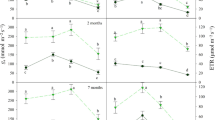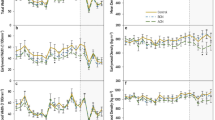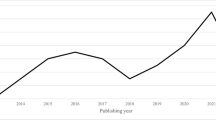Abstract
Lime-trees (Tilia begonifolia Stev.) have countless ecological and economical values in the northern forests of Iran. Bole wounds on residual trees are commonly caused by logging. The healing ability of bole wounds and the effect of bole wounds on diameter growth in lime-trees were assessed in a natural mixed uneven-age stand. The susceptibility to decay in relation to the wound severity was also evaluated. Condition and location of lime-trees before and after selective logging were determined through systematic plot sampling. The position of each lime-tree was identified on a topographical map using the global positioning system. After 10 years from wound occurrence, tree and wound characteristics were also re-measured. Overall, 68 stems (9.7 stem ha−1) of lime-trees were found in the sampled area, 25 stems (36.8%) were damaged in the form of bole wound, and 43 stems (63.2%) were undamaged. Statistical differences between wounded or non-wounded lime-trees in terms of diameter and height were not found. Most of the wounds occurred at the height of < 1 m; the average wound size was 370.5 cm2. Wound severity was related to wound size and wound position. Wound width healing rate was 6.2 mm year−1. The wound shape was found to be a healing factor as the healing rate by width was higher than that by length. Healed wounds were only 12, 60% of bole wounds resulted in decay. Diameter growth of wounded trees was 43.5% lower than undamaged trees. The average annual diameter growth decreased by increasing wound severity. The results indicated the lime-tree is a very sensitive species to damage caused by logging (bole wound). Single-tree selection cutting needs more careful logging operations to reduce damage on residual lime-trees in order to safeguard this species, valuable in ecologic and economic terms.





Similar content being viewed by others
References
Annesi T, Calienno L, Picchio R, De Simone D, Lo Monaco A (2015) Degradation of some technological features in the wood of ornamental species caused by Inonotus rickii (PAT.) REID. DREWNO 58:5–18. https://doi.org/10.12841/wood.1644-3985.136.01
Behjou FK (2014) Effects of wheeled cable skidding on residual trees in selective logging in Caspian forests. Small Scale For 13(3):367–376
Behjou FK, Majnounian B, Namiranian M (2015) Technical analysis of created scars on the edge trees of skid-trail due to skidding operation. J For Wood Prod 67(4):541–552
Bertolotto P, Calienno L, Conforti M, D’Andrea E, Lo Monaco A, Magnani E, Marinšek A, Micali M, Picchio R, Sicuriello F, Spina R, Venanzi R (2016) Assessing indicators of forest ecosystem health. Ann Silvic Res 40(1):64–69
Bonyad A, Tavankar F (2016) Investigation on resistance of different tree species to logging wounds (Case study: district 1 of Asalem-Nav forest). J For Wood Prod 68(4):741–756 (In Persian)
Bragg W, Ostrofsky W, Hoffman B (1994) Residual tree damage estimates from partial cutting simulation. For Prod J 44(7–8):19–22
Clark DA, Clark DB (1992) Life history diversity of canopy and emergent trees in a neotropical rain forest. Ecol Monogr 62:315–344
Danilović M, Kosovski M, Gačić D, Stojnić D, Antonić S (2015) Damage to residual trees and regeneration during felling and timber extraction in mixed and pure beech stands. Šumarski list 5–6:253–262
Edlmann Abbate ML (2002) Catalogue of the wood species used in the cabinet work. In: Borghini G. and Massafra M.G. (Eds.) Woods for cabinet work De Luca Edizioni D’Arte, Roma, pp 153–154 (In Italian)
Fjeld D, Granhus A (1998) Injuries after selection harvesting in multi-storied spruce stands—the influence of operating systems and harvest intensity. Int J For Eng 9(2):33–40
Gullison R, Hardner J (1993) The effects of road design and harvest intensity on forest damage caused by selective logging: empirical results and a simulation model from the Bosque Chimanes, Bolivia. For Ecol Manag 59:1–14
Han HS, Kellogg LD, Filip GM, Brown TD (2000) Scar closure and future timber value losses from thinning damage in western Oregon. For Prod J 50(1):36–42
Hecht U, Kohnle U, Nill M, Grüner J, Metzler B (2015) Bark wounds caused by felling are more susceptible to discoloration and decay than wounds caused by extraction in European beech. Ann For Sci 72(6):731–740
Jourgholami M, Rizvandi V, Majnounian B (2012) Evaluating the extent, patterns, size and distribution of tree scars following skidding operation (case study: Kheyrud forest) Iran. J For 4(3):187–196 (In Persian)
Kovbasa NP (1996) Distribution and spreading of wound rot in Belarus Spruce stands and measures to limit the losses. Ph.D. Dissertation Belarusian Plant Protection Research Institute, Priluki, Minsk
Leben C (1985) Wound occlusion and discoloration columns in red maple. N Phytol 99(3):485–490
Madhoushi M (2016) Species and mechanical strengths of wood members in a historical timber building in Goran (North of Iran). BioResourches 11(2):5169–5180
Majnounian B, Jourgholami M, Zobeiri M, Feghhi J (2009) Assessment of forest harvesting damage to residual stands and regenerations- A case study of Namkhaneh district in Kheyrud forest. Environ Sci 7(1):33–44 (In Persian)
Marchi E, Picchio R, Spinelli R, Verani S, Venanzi R, Certini G (2014) Environmental impact assessment of different logging methods in pine forests thinning. Ecol Eng 70:429–436
Marchi E, Picchio R, Mederski PS, Vusić D, Perugini M, Venanzi R (2016) Impact of silvicultural treatment and forest operation on soil and regeneration in Mediterranean Turkey oak (Quercus cerris L.) coppice with standards. Ecol Eng 95:475–484
Marvie-Mohadjer M (2006) Silviculture. Tehran University Press, Tehran (In Persian)
Naghdi R, Rafatnia N, Bagheri I, Hemati V (2008) Evaluation of residual damage in felling gaps and extraction routes in single selection method (Siyahkal forest). Iran J For Poplar Res 16(1):87–98 (In Persian)
Neely D (1970) Healing of wounds on trees. J Am Soc Hort Sci 95:536–540
Nicolescu VN, Sandi M, Păun M (2013) Occlusion of pruning wounds on northern red oak (Quercus rubra) trees in Romania. Scand J For Res 28:340–345. https://doi.org/10.1080/02827581.2012.747621
Nikooy M, Ershadifar M (2012) Effects of skid trail planning, landing construction and directional felling on normal selective logging in Caspian forest. Dubrovnik, Croatia, 8–12 Oct. 2012
Nikooy M, Rashidi R, Kocheki G (2010) Residual trees injury assessment after selective cutting in broadleaf forest in Shafaroud. Casp J Environ Sci 8(2):173–179
Nouri Z, Zobeiri M, Feghhi J, Amiri GZ, Marvie Mohadjer MR (2015) Comparison of woody species diversity between managed and unmanaged forests considering vertical structure in Hyrcanian forests, Iran. Biodiversitas 16:95–101. https://doi.org/10.13057/biodiv/d160113
Parsa-Pajouh D (1984) Wood technology. Tehran University Publication, Tehran
Pelosi C, Calienno L, Fodaro D, Borrelli E, Rubino AR, Sforzini L, Lo Monaco A (2016) An integrated approach to the conservation of a wooden sculpture representing Saint Joseph by the workshop of Ignaz Günther (1727–1775): analysis, laser cleaning and 3D documentation. J Coul Herit 17:114–122
Picchio R, Neri F, Maesano M, Savelli S, Sirna A, Blasi S, Baldini S, Marchi E (2011) Growth effects of thinning damage in a Corsican pine (Pinus laricio Poiret) stand in central Italy. For Ecol Manag 262:237–243
Picchio R, Magagnotti N, Sirna A, Spinelli R (2012a) Improved winching technique to reduce logging damage. Ecol Eng 47:83–86
Picchio R, Neri F, Petrini E, Verani S, Marchi E, Certini G (2012b) Machinery-induced soil compaction in thinning two pine stands in central Italy. For Ecol Manag 285:38–43
Picchio R, Spina R, Calienno Luca, Venanzi Rachele, Lo Monaco A (2016) Forest operations for implementing silvicultural treatments for multiple purposes. Ital J Agron 11(s1):156–161
Poorzadi M, Bakhtiari F (2009) Spatial and temporal changes of Hyrcanian forest in Iran. iForest 2:198–206. https://doi.org/10.3832/ifor0515-002
Popescu CM, Sakara Y, Popescu MC, Osaka A, Vasile C (2005) Degradation of lime wood painting supports. e-Preserv Sci 2:19–29
Sabeti H (2006) Forests, trees and shrubs of Iran. Yazd University Publication, Yazd
Sendi MRN, Navroodi IH, Poorbabaei H, Milan MS, Bakhshandeh B (2014) Determination of lime tree (Tilia begonifolia Stev.) stems form based on quantitative parameters (Study area: Shafaroud forests of Guilan province, Iran). Folia For Polonica Ser A 56(4):165–170. https://doi.org/10.2478/ffp-2014-0018
Sist P, Sheil D, Kartawinata K, Priyadi H (2003) Reduced impact logging in Indonesian Borneo: some results confirming the need for new silvicultural prescriptions. For Ecol Manag 179(1):415–427
Skilling DD (1958) Wound healing and defects following northern hardwood pruning. J For 56(4):19–22
Smith HC, Miller GW, Schuler TM (1994) Closure of logging wounds after 10 years. USDA Forest Service, Research Paper NE-692
Spinelli R, Magagnotti N, Nati C (2010) Benchmarking the impact of traditional small-scale logging systems used in Mediterranean forestry. For Ecol Manag 260:1997–2001
Steyrer G (1992) Extent and economical significance of stem decays in forestry enterprise. Cbl Ges For 109:221–249
Szewczyk W (2015) Wood decomposition by Porodaedalea pini strains from different regions of Poland. Drewno 58(194):127–134
Tavankar F, Bonyad A (2014) Long-term effects of logging damages on quality of residual trees in the Asalem Nav forest. J Environ Stud 40(1):39–50 (In Persian)
Tavankar F, Bonyad A (2017) Characteristics and occlusion of logging wounds in Fagus orientalis Lipsky. Taiwan J For Sci 32(2):87–100
Tavankar F, Picchio R, Lo Monaco A, Bonyad AE (2014) Forest management and snag characteristics in Northern Iran lowland forests. J For Sci 60:431–441
Tavankar F, Bonyad A, Majnounian B (2015a) Affective factors on residual tree damage during selection cutting and cable-skidder logging in the Caspian forests, Northern Iran. Ecol Eng 83(8):505–512
Tavankar T, Bonyad AE, Marchi E, Venanzi R, Picchio R (2015b) Effect of logging wounds on diameter growth of beech (Fagus orientalis Lipsky) trees following selection cutting in Caspian forest of Iran. N Z J For Sci 45(19):1–7
Tavankar F, Nikooy M, Picchio R, Bonyad A, Venanzi R (2017a) Effects of logging wounds on Caucasian Alder trees (Alnus subcordata C.A. Mey.) in Iranian Caspian forests. Croat J For Eng 38(1):73–82
Tavankar F, Picchio R, Nikooy M, Lo Monaco A, Venanzi R, Iranparast Bodaghi A (2017b) Healing rate of logging wounds on broadleaf trees in Hyrcanian forest with some technological implications. Drewno. https://doi.org/10.12841/wood.1644-3985.200.xx
Tavankar F, Nikooy M, Picchio R, Venanzi R, Lo Monaco A (2017c) Long-term effects of single-tree selection cutting management on coarse woody debris in natural mixed beech stands in the Caspian forest (Iran). iForest 10:652–658
Vasiliauskas R (1994) Wound healing rate and its influence spread of decay in spruce. Proc Lith For Res Inst 34:207–212
Vasiliauskas R (1998) Patterns of wounding and decay in stems of Quercus robur due to bark peeling. Scand J For Res 13:437–441
Vasiliauskas R (2001) Damage to trees due to forestry operations and its pathological significance in temperate forest: a literature review. Forestry 74:319–336
Vasiliauskas A, Stenlid J (2007) Discoloration following bark stripping wounds on Fraxinus excelsior. Eur J For Pathol 28(6):383–390
Volkert E, Siuts U, Dierks H (1953) Impact of bark stripping damage on timber quality of beech. Allg Forst Jagdzg 125:277–286
Vusić D, Šušnjar M, Marchi E, Spina R, Zečić T, Picchio R (2013) Skidding operations in thinning and shelterwood cut of mixed stands - Work productivity, energy inputs and emissions. Ecol Eng 61:216–223
White DA, Kile GA (1994) Breakdown of barrier zones and prediction of the spread of discoloration and decay resulting from stem wounds in Eucalyptus regnans and E. obliqua. Eur J For Pathol 24:71–78
Whitman A, Brokaw N, Hagan H (1997) Forest damage caused by selection logging of mahogany in northern Belize. For Ecol Manag 92(1):87–96
Zare H, Amini T, Assadi M (2012) A review of the genus Tillia L. (Tiliaceae) in Iran, new records and new species. Iran J Bot 18(2):175–190
Author information
Authors and Affiliations
Corresponding author
Additional information
Communicated by Martina Meincken.
Rights and permissions
About this article
Cite this article
Tavankar, F., Lo Monaco, A., Picchio, R. et al. Healing ability and diameter growth of lime-trees (Tilia begonifolia Stev.) following logging wounds. Eur J Forest Res 137, 45–55 (2018). https://doi.org/10.1007/s10342-017-1089-5
Received:
Revised:
Accepted:
Published:
Issue Date:
DOI: https://doi.org/10.1007/s10342-017-1089-5




